#11th Berlin Biennale
Explore tagged Tumblr posts
Text

news#4 2023 NEWS Studio Philipp Geist / VIDEOGEIST Upcoming & Past Projects
http://videogeist.blogspot.com/2023/12/news4-2023-news-studio-philipp-geist.html
Dear Light Art People Partners Friends,
I would like to provide information about my current activities and previous and upcoming projects and work.
From December 29th to January 14th I will be showing my site-specific installation 'Time Drifts Bremen' on the occasion of the 'Lights of the City' light festival in Bremen. The project is part of the Time Drifts series. For the installation, I portrayed people in Bremen and collected terms and words that I will integrate into my picturesque abstract worlds in the installation at Bremen's St. Peter's Cathedral. The installation will be on view daily from 12/29/23 to 01/14/24 from 4:30 p.m. to 10 p.m.
I am currently part of the group exhibition 'Companions' at the Museum of Non-Objective Art in Otterndorf / Cuxhaven. The exhibition is open until March 17, 2024.
I am currently showing in Mexico as part of the Guadalajara International Book Fair and as part of the exhibition 'Artistic Expressions in Contemporary Europe', an immersive digital art experience with works by 40 European artists will be on view until February 24, 2024. I am 'SÄTEET' with the audio/visual work. The MUSA Museo de las Artes at the University of Guadalajara will present “Immersive digital art experiences: a sensory journey into the world of fantasy,” curated by Stefano Fake.
The permanent installation has been on display in the Predigerkirche in Eisenach since October 1st. The walk-in installation on St. Elisabeth can be seen during the museum's opening hours.
In the last few weeks and months I have been able to realize further projects/work and installations.
On Fri September 1st and Saturday September 2nd I showed the installation 'spectrum 2023' at the historic Lahn Bridge in Wetzlar. On the occasion of the anniversary '250 Years of Goethe in Wetzlar' in 2022, I developed a video/light installation. Lukas Taido developed the music specifically for this. Speaker Mathias Kopetzki. On the weekend of September 8th - 10th the group exhibition ' Farbappartat ' took place in the Monopol Berlin. Works by Jan Muche, Oliver Lanz, Elisabeth Sonneck and pictures from Bernd Wolf's estate were shown in the spectacular former factory rooms. There I showed my paintings and painting mappings (combination of projection mapping and painting). My installation GLOWING TIMES (30 YEARS OF THE ZOLLHAUS) took place in Leer at the historic Zollhaus between September 22nd and 30th, 2023. On September 22nd and Saturday, 23rd, my installation 'ZEIT & TIMES' could be seen at the Fehnturm in Herzogenaurach. At the end of September I showed the installation 'Time Drifts Trier' at the historic cathedral on the newly named Human Dignity Square.
On October 9th, on the day of the peaceful revolution, I showed the project 'We - Leipzig' at the New Town Hall on the occasion of the LICHTFEST LEIPZIG 2023. The music and composition was composed by Lukas Taido himself. A Leipzig chamber choir of around 35 members under the direction of Andreas Reuter sang live from the New Town Hall onto the facade on which I had projected.
The film of the installation can now be seen online at
MOVIE ONLINE
Wir Leipzig 09. Oktober 2023 Lcihtfest Leipzig
<<https://vimeo.com/manage/videos/895833458>>
The 11th Hohler Biennale 2023 'LandUNTER' took place in Gera from July 21st to October 13th, 2023. I showed my long-term project Riverine Zones to the cavers in the underground former beer cellars. In November I was represented with the installation 'Digital Romantic' at the Glanzlichter Festival in Fürth. The first Katerbow Leuchtet, which I initiated, also took place in November. To do this, I implemented installations at various locations in Katerbow near Netzeband/Neuruppin.
I'm also working on my painting and analogue images.
All the best and LightsON!
I wish everyone a nice end to the year and a merry Christmas!
Philipp Geist
1 note
·
View note
Photo

11th Berlin Biennale: On the Human Condition
An interview by Katerina Valdivia Bruch for the journal On Curating
The 11th Berlin Biennale chose to start its activities one year before its opening date. Following a process-based curatorial approach, the team of four curators began its undertaking at the ExRotaprint complex, working in small groups, and involving the locals and the artistic community. The programme includes reflections and discussions around vulnerability, care and solidarity, as well as extractivism, fanaticism and the rise of nationalisms. While a worldwide pandemic has forced us to stop and go back to basics, all these issues have become more urgent than ever. We spoke with the curators on creating sustainable relationships, doing things on a human scale, and the meaning of community in times of the pandemic.
The Female Voice and Ways of Working from the South
Katerina Valdivia Bruch (KVB): In recent years, political identity has been a recurring topic in the arts field. The team of curators of the 11th Berlin Biennale presents itself as a female voice. What do you mean by that?
Agustín Pérez Rubio (APR): Today, after decades of feminism and queer theory, of theories on political thought around gender, there is still – mainly in society, but also in the arts field–a macho way of thinking and a reduction of powers, managed mostly by men.
When we speak about the feminine, we do not only group what is not the masculine. What we are actually doing is seeking to break the idea of machismo. As you know, in our countries – Argentina, Brazil, Chile and Spain – the situation of violence against women and LGBTQ communities is horrendous. That is why we are interested in defeating this macho and violent view of reality that is present and reproduced in many institutions as well.
KVB: How does this voice manifest itself?
APR: It's about not imposing positions, not having prejudices, being open to communication, or doing something between several people. We, with our curator's voices, are a small example of this, but you will see that several projects of the Biennale are collaborations between different artists. The idea of process, that is at the core of our project for the Biennale, is also a way of understanding this kind of voice. Also, by slowing down the machinery of the Biennale itself, in favour of more sustainable relationships with the locals and with the idea of care. All these are modes of trying to change our ways of doing and saying, which are based on feminist and queer accounts.
KVB: The South is a concept implicit in the Biennale's proposal. How would you define it? What characterises it?
Renata Cervetto (RC): We bring different ways of doing things. For example, in the way each one of us thinks the programme or an exhibition, or in our communication with other people. Improvisation comes into play, but also a different way of planning, in which things are not so regulated. We are always in this negotiation, between a less formal structure and an established institution, trying to generate more porous and fluctuating processes that adapt to the requirements of each situation.
APR: Actually, we are not thematising the South, but there is a part of our South that is impregnated in ourselves. And, with this, I don't mean only a geopolitical relationship. What interests us is to explain that there are other achievements, lessons and theories, that come from our South and from there extend to the Global South.
Establishing Sustainable Relationships
KVB: Why did you start your first actions at the ExRotaprint building complex in Wedding, a popular neighbourhood with a fairly high migrant population?
APR: It was clear to us that we didn't want to work in the city centre, nor within an art facility. We were also very careful to not further accentuate the gentrification that has already happened in certain areas of the city, occasionally as a result of the arts context. We wanted to find an initiative that was already working, an umbrella containing social, artistic, and business parts in equal terms, as it is the case of the projects developed by the ExRotaprint community. In fact, we didn't choose to work in Wedding. We chose to work with ExRotaprint, that happened to be located in Wedding. The district interested us, because of its migrant communities and also because there are other artistic initiatives nearby that have been working for some time in this neighbourhood.
RC: When we began to think about the project, we were asking ourselves how we could work with the format of the Biennale in such a way that it would generate a sort of commitment, not only with the city, but also with the people we are working with. We are not revolutionising the space or bringing in novelty. For us, it's more about integrating what people can bring to the project from what they are already doing, from their own initiatives. And that takes more time, more presence from us in the space, a different engagement. One example of this are the schools we were working with in the first stage. We offered them a project that might work for their curriculum, and opened up the space to develop it.
APR: With all this, what we are trying to do is to point out how a biennial might help to establish sustainable relationships and intertwine different agents: artistic, social, economic, political, etc., within a city, among themselves and with the rest of the community. We consider it fundamental to understand the Biennale as an open process that includes the neighborhood, the people and its initiatives, and, of course, the artistic community of Berlin. Besides this, our space at ExRotaprint is a sort of tribute to the famous CAM (Club de Artistas Modernos, English: Club of Modern Artists), founded in 1932 by Brazilian artist Flávio de Carvalho (1899-1973), who is like our ally in this Biennale's edition. We are trying to bring Flávio's experiences back to the present, and also include the current experience we are going through due to the pandemic. While the CAM of São Paulo proposed a kind of open artist workshop for the community, our idea is that of an open curatorial process, in collaboration with and open to our social surroundings in Wedding and with the ExRotaprint building complex.
Reflecting from the Arts
KVB: What were the reasons to choose to work with Flávio de Carvalho's legacy for the first phase of the Biennale?
Lisette Lagnado (LL): I have always been attracted to working with artists who have a conceptual density. For instance, I have spent many years researching Hélio Oiticica's writings. For me, it was no longer important to show his work, which was widely known, but rather to present his urban and environmental programme for the public space. The case of Flávio de Carvalho is also an example of an artist with multiple interests, including anthropology, psychoanalysis, architecture, etc. I could have started referring to theorists such as Walter Benjamin or Hannah Arendt, philosophical figures who have formed my own theoretical background, but I needed to start from an artist's point of view. This allows the Biennale to have a more conceptual structure. Of course, it is completely legitimate to take references from theorists or social scientists, but it is different to work with an artistic perspective as an entry point. From there, we can elucidate common points, difficulties or contradictions, and then contrast them with the present.
María Berríos (MB): For us, it was necessary to have something, a kind of vehicle or guiding principle that was familiar to us. This was one of the reasons why we chose to work with Flávio de Carvalho's artistic practice.
LL: We began to think about Flávio's failed experiences and how they could be contextualized today. The idea of experience brings with it the idea of failure as well, of things that don't turn out the way one wants. We are interested in dismantling a modernist narrative that only chooses the highlights within a trajectory and doesn't problematise the failures. Flávio was considered a transgressor in his time, and this also reflects how civilization has been thought of over the years.
On Building Alliances and Collective Work
KVB: The Museo de la Solidaridad Salvador Allende (Salvador Allende Solidarity Museum), presented as part of the Biennale, was inaugurated in 1972 by Brazilian art critic and journalist Mário Pedrosa, who was in exile in Chile at that time. What is the meaning of the museum in today's context?
MB: The history of the Museo de la Solidaridad has been usually told either from Allende's or from Pedrosa's perspective. But, the truth is that the principles of the museum were developed long before that. In the late 1950s in Chile, for example, there were a number of initiatives that took art to remote locations, by train or by bus, managed by an entourage of artists. The museum project itself was the collective work of a group of Chilean artists, journalists, and art historians. They were the ones who invited Mário Pedrosa to take on the direction of the museum. Many artists, including the strategic incorporation of some internationally renowned artists at the time, donated works as a political act of solidarity with the Chilean people and their struggle.
The generation of alliances between more fragile positions and the need to bring together vulnerabilities, principles that were at the base of the museum's establishment, are present in what we are doing for the Biennale. I think the Museo de la Solidaridad is an exceptional experiment in that sense.
Solidarity and Care in Times of the Pandemic
KVB: The Biennale had to close its exhibition space due to the outbreak of the coronavirus disease (Covid-19). What reflections can be drawn from this worldwide pandemic?
LL: Before closing our space, the Biennale had more than 50 invited participants. Several projects were already taking place. In the midst of all these changes, I began to reflect on how we would be able to process such a radical global change. Immediately, the motto “ninguém solta a mão de ninguém” (no one should release the hand of anyone) came to my mind. This slogan arose in 2018, as soon as the results of the presidential elections in Brazil were known. Many people went out to the streets to protest against the newly elected president Jair Bolsonaro, known for his racist and sexist statements. However, the vast majority were afraid to go out alone to demonstrate, because inside the crowd were infiltrated members of law enforcement agencies and police, who generally use violence against protesters. That phrase, told by a mother to her daughter, just before the latter was about to leave the house to protest, allowed us to feel the strength of the collectivity, of a united and protective crowd. And now I think: our strength, the fact of holding the hand of our peers, has become a danger of contagion. What a cruel contradiction!
MB: At the moment, it is fundamental to insist on different ways of supporting each other. A “social distance” is demanded, but what is actually needed is to think socially, to take care of one another. This is not just an individual or isolated act —it is a social act. The virus accentuates inequality, which means that those who will perish will be the most vulnerable. It is essential to reflect on how people are going to meet again during and after the pandemic. Instead of this, what is unfolding around the world are severe measures, typical of authoritarian regimes: border closures, police and military deployments, restrictions on free movement or citizen denunciations. The current situation forces us to think about how to slow things down, to return to a more human scale, without accentuating the fierce elitism and violent exclusion that are already structural to and systematically reproduced by the cultural institutions we work in.
RC: I believe the change has to happen first in oneself, in order to be able to transmit and generate a collective consciousness of care. This virus makes it clear: any decision one makes in relation to one's body is going to affect others sooner or later. Coping with this virus implies trusting strangers, trusting that there is someone else who takes care of herself/himself in order to take care of me as well. It is a very powerful gesture, since it generates a network of containment and support among people. We are privileged, because we have a job that allows us to think of new ways to meet and, from there, continue to build a joint journey. This also entails a great responsibility, because it is not a change that will happen in a year. It will take time to meet again, not only physically, but also emotionally and from our own feelings.
LL: Several of the urgent issues we are experiencing right now were already part of our agenda for the Biennale, among them the emphasis on the local audience, small meetings on a human scale, as well as issues on solidarity and crisis management, a job mostly done by women. Right now, borders have been closed again. This is something against essential human rights, such as mobility and the right to life, especially in the case of migrants and refugees. How can we re-found a community of human beings in a situation of confinement, prohibition of mobility, and restrictions on physical contact? It is too early to draw conclusions about this pandemic, but enough to observe that neoliberalism is fueling human arrogance, instead of reassessing and putting into place the necessary measures to provide a greener economy and global solidarity. I would like to finish with a sentence by the artist duo The Black Mamba, that sums it up quite well: “Some curves will not be flattened”.
Translation from Spanish: Katerina Valdivia Bruch
This interview took place in September 2019 at KW Institute for Contemporary Art and ExRotaprint. It was updated in May 2020, during the outbreak of the coronavirus (Covid-19) pandemic.
A shorter version of this interview, with the title “11ª Bienal de Berlín: Voces femeninas, acciones colectivas y enfoques desde el Sur”, was first published in November 2019 in the online magazine of Goethe-Institut Argentina (in Spanish and German). The Portuguese version was published in May 2020 in the online magazine of Goethe-Institut Brasil.
Katerina Valdivia Bruch is a Berlin-based independent curator and arts writer. She holds a BA in Philosophy (Pontificia Universidad Católica del Perú), a Cultural Policies and Management Diploma (Universitat de Barcelona), and an MA in Museum Studies and Critical Theory (Independent Study Programme, MACBA/Universitat Autònoma de Barcelona). Katerina has curated exhibitions and organised symposia, talks and lectures for a number of institutions, including ZKM-Center for Art and Media Karlsruhe, Bielefelder Kunstverein (Bielefeld), Grimmuseum (Berlin), CCCB (Barcelona), Instituto Cervantes (Berlin and Munich), Instituto Cultural de León (Mexico), Para/Site Art Space (Hong Kong), and the Institute of Contemporary Arts Singapore. In 2008, she was co-curator of the Prague Triennale at the National Gallery in Prague. Besides her work as a curator, she contributes essays, interviews and articles to art publications and magazines. Among her publications are several articles and interviews on previous editions of the Berlin Biennale, Biennale Jogja, Kochi-Muziris Biennale and Manifesta Biennale. For more information, visit www.artatak.net
Notes
11th Berlin Biennale The 11th Berlin Biennale for Contemporary Art is conceived as an extended process of unfolding artistic projects and encounters. The Biennale's presence in the city has not been limited to the dates of the exhibition. The intergenerational, female identified team of curators is composed by María Berríos from Chile, Renata Cervetto from Argentina, Lisette Lagnado from Brazil, and Agustín Pérez Rubio from Spain. They started to build up their programme in a temporary space at the architectural complex ExRotaprint, located in the district of Wedding.
The curatorial group was established from its personal backgrounds and affinities with South America, mainly Brazil, Chile and Argentina. The three countries, together with Spain, form a particular constellation, which served as a starting point for discussing various social and political issues that we are currently experiencing, such as the "return" of racist and fascist manifestations, the growth of hate speech and religious fanaticism, the appreciation of an ecological feminism, among others.
Over the last few months, the curators have developed a series of experiences in three moments:
exp. 1: The Bones of the World The experience of arriving in Berlin was marked by the meteorite that survived the fire that burned down the National Museum in Rio de Janeiro in September 2018. It is an attempt to hold on to the complicated beauty of life when the fire erupted. It is not an obsession with the ruins, but an attempt to be attentive to what is made with the rubble. A way of working with and remaining beside that which moves us now.
exp. 2: Virginia de Medeiros and the Feminist Health Care Research Group Series of discussions and meetings on topics such as the repoliticisation of health and illness, care, accessibility and sharing vulnerabilites, amongst others.
exp. 3: Affect Archives, with Sinthujan Varatharajah and Osías Yanov Recollection and reflections on bodily memories and practices of survival, communion, borders and mobility, through different political and affective geographies.
Since September 2019, the 11th Berlin Biennale for Contemporary Art has been unfolding as a process through a series of lived experiences with exp. 1, exp. 2 and exp. 3. In a fourth step, conceived as an epilogue, the 11th Berlin Biennale will bring these experiences together with artistic participations from around the world. In their diverse modes of articulating solidarity, fragility and resistance, these contributions rise up to materialise the complicated beauty of life amidst the turbulent times we inhabit.
The Corona pandemic has affected the preparations for the 11th Berlin Biennale, which was originally scheduled from June 13 to September 13, 2020. We are currently looking into new dates, in close cooperation with the German Federal Cultural Foundation and the exhibition venues. The dates will be made public as soon as they are determined.
Berlin Biennale für zeitgenössische Kunst (11th Berlin Biennale for Contemporary Art) https://11.berlinbiennale.de/
Image: Installation view exp. 1: The Bones of the World, 7.9.–9.11.2019, 11th Berlin Biennale, ExRotaprint, Photo: Mathias Völzke
#Berlin Biennale#11th Berlin Biennale#Lisette Lagnado#Renata Cervetto#Agustín P��rez Rubio#María Berríos#Katerina Valdivia Bruch#On Curating#Contemporary art#Berlin
0 notes
Photo

The 11th Berlin Biennale for Contemporary Art
#11th Berlin Biennale c/o ExRotaprint#Óscar Fernando Morales Martínez#Adelina Gomes#Agustín Pérez Rubio#Alfredo Echániz#Aline Baiana#Andrés Fernández#Andrés Pereira Paz#Anita Beikpour#Antônio Araújo#Antonio Duran#Antonio Pichilla#Aurora Cursino dos Santos#Aykan Safoğlu#Azucena Vieites#Balz Isler#Bartolina Xixa#Beatriz González#Berlin Biennale 11#Brenda V. Fajardo#Cansu Çakar#Carlos Motta#Carlos Pertuis#Castiel Vitorino Brasileiro#Cecilia Vicuña#Christine Meisner#Cian Dayrit#Claude Lazar#Clemencia Lucena#Colectivo de Serigrafía Instantánea
57 notes
·
View notes
Photo
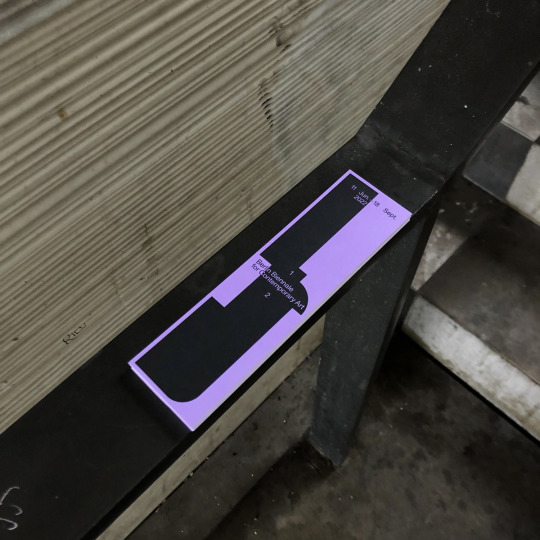
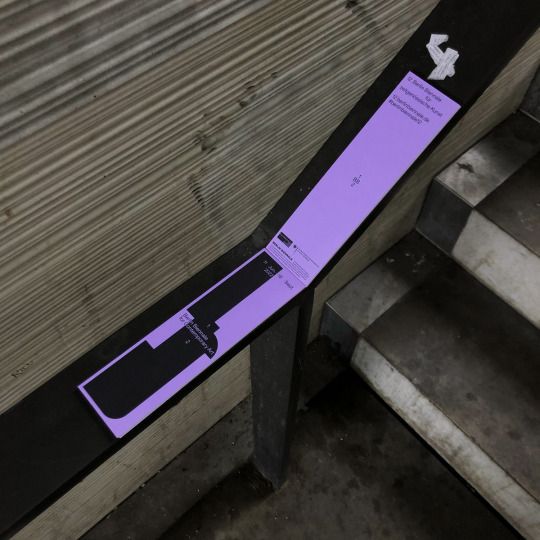
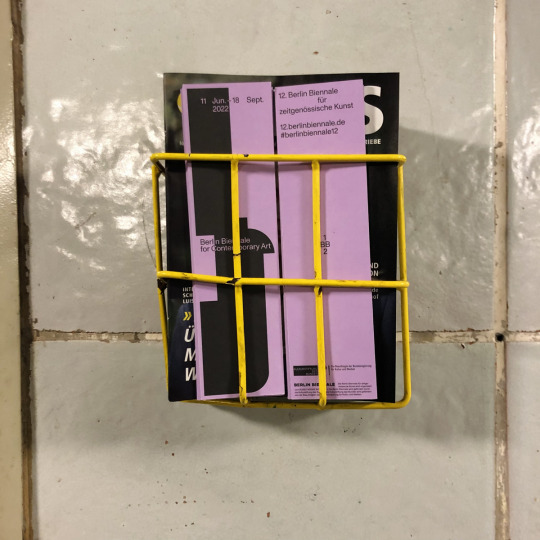

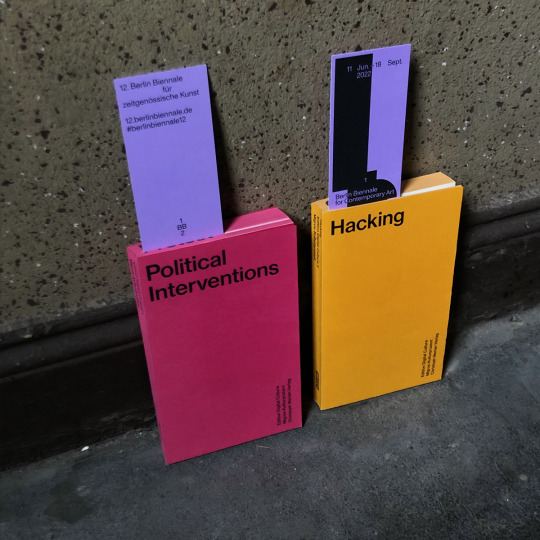
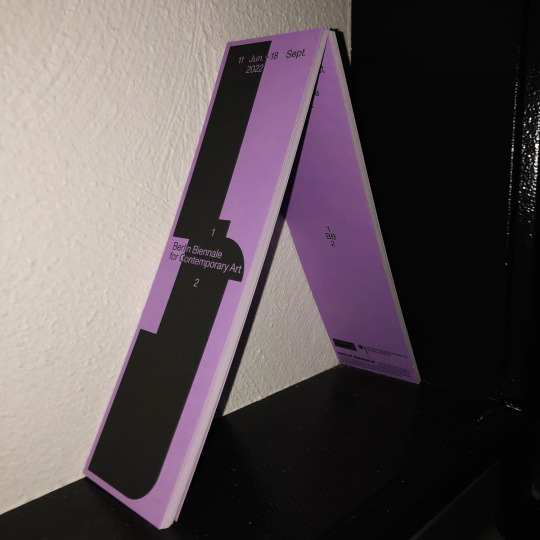
THE STREETS WRITE STORIES. STORIES MAKE GREAT BOOKS. 📚 📖 📕 Sexy Bookmarks together with @martinwecke.de for @berlinbiennale👀 watch out, they’ll help you not only not getting lost while reading, they are also a constant reminder that the 12th Berlin Biennale for Contemporary Art takes place from June 11th—September 18th • Type in use Monument Grotesk by @abcdinamo
#berlinbiennal#berlinbiennale12#bookmarks#visualidentity#visualsystem#graphicdesign#keyvisual#martinwecke#monumentgrotesk#abcdinamo#streetswritestories
8 notes
·
View notes
Text

11th Berlin Biennale for Contemporary Art announces dates and venues for epilogue. BMW again Corporate Partner of the 11th Berlin Biennale for Contemporary Art. http://dlvr.it/RPMWkx http://dlvr.it/RPMWkx
1 note
·
View note
Text
Residents Hafiz Rancajale and Otty Widasari

👉 We have new residents Hafiz Rancajale and Otty Widasari
Hafiz Rancajale Curator, artist and filmmaker. Lives and works in Jakarta. He is one of the founders of Forum Lenteng. Hafiz finished his studies of Fine Arts at Jakarta Institute of Art in 1994. In 2013, he was Artistic Director of Jakarta Biennale SIASAT. Now, Hafiz works as Artistic Director for Arkipel - Jakarta International Documentary & Experimental Film Festival.
Otty Widasari Artist, writer and filmmaker. One of the founders of Forum Lenteng. In 1992 -1995, she studied journalism at Institute of Social Science and Politic. Otty finished her study in Fine Arts at Jakarta institute of Art in 2013. Her works has been presented at OK. VIDEO Militia – 3rd Jakarta International Video Festival, Jakarta (2007); 5th Singapore Film Festival, (2009); 11th Barcelona Asian Film Festival, Spain (2009); International Film Festival Rotterdam (2009); Translated SPACE, ID Contemporary Art of Indonesia, Kunstraum Krausberg, Berlin (2010); OK. VIDEO Flesh – 5th Jakarta International Video Festival (2011); 4th DMZ International Documentary Film Festival, Korea (2012); Jakarta Biennale – SIASAT, Jakarta (2013); Biennale Jogja XII Equator #2, Yogyakarta (2013); SeMA Biennale Mediacity Seoul, Korea (2014); Bienal de la Imagen en Movimiento Buenos Aires, Argentina (2014); Impakt Festival, Utrecht (2014); Experimenta – 9th International Festival of Moving Image Art, Bangalore, India (2015); Images Festival, Toronto, Kanada (2015); dan L’Age d’Or Festival, Brussels, Belgia (2016), Jakarta Biennale "JIWA" (2017), OK. VIDEO | OK. PANGAN (2017)
2 notes
·
View notes
Photo

.
IN RESIDENCE:
Renata Cervetto (Buenos Aires) has been awarded one of the NOTAR research residencies and will be at Planta Alta during the months of March and April 2022.
Renata’s project is part of the “archive and memory” research unit, and aims to develop an archive based on the pedagogical journey of the Reina Sofía Museum (2008-2020) in dialogue with other institutions and agents based in Spain. The project also traces the intersections and resonances between Spain and Latin America around these educational practices, mainly considering the influence that certain biennials (with their artists and curators) have had on the development of the field.
Renata Cervetto has a degree in Art (Universidad de Buenos Aires, 2011) and graduated from the curatorial program of the Appel arts center in Amsterdam (2013-2014). In 2014 she obtained the first Curatorial Fellowship awarded by the Ammodo Foundation (NL), for which she investigated artistic and curatorial practices in dialogue with pedagogy. This practical and theoretical work has been compiled in the book The Fellow Reader #1. On Boycotts, Censorship and Educational Practices (from Appel art centre, 2014). Between 2015 and 2018 she was Coordinator of the Education Department of MALBA (Museum of Latin American Art of Buenos Aires). In 2016, she co-edited Shake Before Use. Educational, social and artistic displacements in Latin America with Miguel A. López (TEOR/éTica and MALBA. 2017). Between 2019 and 2020, she was one of the curators of the 11th Berlin Biennale, The cracks begin within, together with Agustín Pérez Rubio, María Berríos and Lisette Lagnado.
.
NOTAR is one of the three nodes of the MAR platform, promoted by hablarenarte, the Museo Nacional Reina Sofía and the Fundación Daniel y Nina Carasso
.............................................................
.
EN RESIDENCIA:
Renata Cervetto (Buenos Aires) es una de las beneficiarias de las residencias de investigación NOTAR y estará durante los meses de marzo y abril de 2022 en Planta Alta.
Su proyecto está dentro de la línea de investigación archivo y memoria, y desarrolla un abordaje del recorrido pedagógico del Museo Reina Sofía (2008-2020) en diálogo con otras instituciones y agentes radicados en España. El proyecto también rastrea los cruces y resonancias entre España y Latinoamérica en torno a estas prácticas educativas, considerando principalmente la influencia que ciertas bienales (con sus artistas y curadores) han tenido en el desarrollo de este campo.
Renata Cervetto es Licenciada en Arte (Universidad de Buenos Aires, 2011) y egresada del programa curatorial del Appel arts centre en Amsterdam (2013-2014). En 2014 obtuvo la primer Fellowship Curatorial otorgada por la Fundación Ammodo (NL), para la cual investigó prácticas artísticas y curatoriales en diálogo con la pedagogía. Este trabajo práctico y teórico ha sido compilado en el libro The Fellow Reader #1. On Boycotts, Censorship and Educational Practices (de Appel art centre, 2014). Entre 2015 y 2018 fue Coordinadora del área de Educación de MALBA (Museo de Arte Latinoamericano de Buenos Aires). En 2016, co-editó la publicación Agítese antes de usar. Desplazamientos educativos, sociales y artísticos en América Latina junto a Miguel A. López (TEOR/éTica y MALBA. 2017). Entre 2019 y 2020, fue curadora de la 11th Berlin Biennale, The cracks begin within, junto a Agustín Pérez Rubio, María Berríos y Lisette Lagnado.
.
NOTAR es uno de los tres nodos de la plataforma MAR, impulsada por hablarenarte, el Museo Nacional Reina Sofía y la Fundación Daniel y Nina Carasso.
0 notes
Text
Virtual Exhibition Highlighting Diasporan Armenian Responses to Occupied Artsakh Launched in April
New Post has been published on https://armenia.in-the.news/culture/virtual-exhibition-highlighting-diasporan-armenian-responses-to-occupied-artsakh-launched-in-april-72970-04-05-2021/
Virtual Exhibition Highlighting Diasporan Armenian Responses to Occupied Artsakh Launched in April

“Sites of Fracture: Diasporic “Imaginings of Occupied Artsakh” exhibition launched on April 19
GLENDALE—Glendale Library Arts & Culture and ReflectSpace Gallery present “Sites of Fracture: Diasporic Imaginings of Occupied Artsakh,” a virtual exhibition that brings together diasporan Armenian artists—from the United States, Canada, and Germany—to build collective counter-narratives to the forces of occupation and cultural erasure in the Republic of Artsakh. The exhibition launched on April 19.
In September 2020, the autocratic state of Azerbaijan invaded the Republic of Artsakh and initiated an campaign of ethnic cleansing targeting its Indigenous Armenian population. With a vastly out-financed military and direct support from Turkey, Azerbaijan succeeded in occupying large swaths of Artsakh. In the process, thousands lost their lives and 100,000 Armenians were displaced from their ancestral homes.
The global Armenian diaspora was gripped by the collective trauma of watching a campaign of ethnic cleansing unfold via digital screens and televisual transmissions. As Indigenous Armenian heritage faced systematic destruction, a cadre of diasporan Armenian artists responded with projects that counter the attempted erasure of Armenian identities, histories, and cultural artifacts.
Artists and cultural workers in the exhibit include Kamee Abrahamian, Ali Cat/Entangled Roots Press, Silvina Der-Meguerditchian, Naré Mkrtchyan, Nelli Sargsyan, She Loves Collective, Scout Tufankjian, Anahid Yahjian and Yerazad Coalition.
“Sites of Fracture” also gestures towards the repatriation of ancestral lands. The virtual exhibition takes place in the photographically reconstructed fortress of the city of Shushi—Artsakh’s historical cultural capital, now occupied by Azerbaijan. In the process, “Sites of Fracture” imagines decolonized futures for Shushi, envisioning an independent Republic of Artsakh wherein Indigenous communities exercise the right to have been granted the right to self-governance and cultural autonomy.
“Sites of Fracture: Diasporic Imaginings of Occupied Artsakh” is co-curated by Mashinka Firunts Hakopian, Ara Oshagan, and Anahid Oshagan and is part of the Glendale Library Arts & Culture’s Armenian Genocide Remembrance Month. The exhibition launches on April 19 in a 3D virtual gallery accessible through the ReflectSpace Gallery website: www.reflectspace.org.
“Sites of Fracture” is also part of the Glendale Library Arts & Culture’s “Be the Change” series focuses on: Inclusion – Diversity – Equity – Antiracism. “Be The Change” events will build collective understanding of systemic racism, elevate the voices and stories of BIPOC, and inspire our community to be the change. “Be The Change” is sponsored by the City of Glendale, California Arts and Culture Commission, with funding from the City of Glendale Urban Art Fund.
ReflectSpace Gallery at the Glendale Central Library opened in 2017 when the library reopened after a major renovation. It came at the behest of The Glendale City Council for a city space to address the Armenian Genocide and other human atrocities. ReflectSpace is an exhibition space designed to explore and reflect on genocides, human and civil rights violations. Immersive in conception, ReflectSpace is a hybrid space that exhibits contemporary art as well as archives, employing installation, technology and interactive media to engage viewers on an emotional and personal level. ReflectSpace strives to reflect the past and present of Glendale’s communal fabric and interrogate current-day global human rights issues.
Kamee Abrahamian is a supreme hyphenate who arrives in the world today as an interdisciplinary writer-artist-producer-performer-organizer and a non-binary, queer-feminist caregiver. They grew up in an immigrant suburb of Toronto and was born into an Armenian family displaced from the SWANA region. Kamee’s work is steeped with relational and generative practices oriented towards ancestral reclamation, visionary fiction, and diasporic futurism. They hold a BFA/BA in film and political science (Concordia University), an MA in expressive art therapy (European Graduate Institute), and a PhD (ABD) in community liberation, indigenous and eco psychologies (Pacifica Graduate Institute). Kamee has published plays, literary and academic writing, while organizing and presenting films, artwork, staged performances and workshops internationally. Recent projects worth mention are “Ensouled,” “Hok Danil,” “Transmission,” and “Dear Armen.”
Ali Cat/Entangled Roots Press is an artist and print maker living on unceded Cowlitz, Multnomah and Confederated Tribes of Grand Ronde land at the confluence of two rivers, also known as Portland, Oregon. She produces her work under the name Entangled Roots Press. Her prints mingle the literal and metaphorical to illuminate and comment upon the world around us. Relief, screen, and letterpress prints span from the carnage of clear-cuts to the beauty of peoples movements. Ali’s prints pull from ancestral herstories and push towards liberatory futures; entangling lessons from gardens, symbols in coffee cups, woven threads from Armenia and Euskal Herria, to the printed page. Ali received her BFA at Pacific Northwest College of Art in Portland. She completed an artist-residency at Proyecto’ace in Buenos Aires in 2014, and was a member of Flight 64, a member-run, nonprofit print studio, from 2015 to 2018. Ali currently works as the Print Studio Technician at PNCA.
Silvina Der-Meguerditchian, born in Buenos Aires, lives and works in Berlin. Her work explores themes of belonging, the role of minorities in society, and the potential of an “in-between” space. Memory and working with archives are the focus of her artistic exploration. She is the artistic director of the Houshamadyan project, a multimedia memory book for Armenian Ottoman history. Silvina Der-Meguerditchian was a fellow at the Tarabya Academy of Culture in 2014/15. In the summer of 2015, she participated in Armenity, the Armenian pavilion at the 56th Venice Biennale, which was awarded the Golden Lion for the best national representation. In the fall of 2015, she curated the exhibition “ENKEL, new geographies of belonging” in Istanbul. Since 2014, she has worked with “Women mobilizing memory,” a group of artists, writers, museologists, social activists, and memory and memorial scholars working internationally. In 2020, her film “The Wishing Tree” was awarded with a Special Mention at the Sharjah Film Platform. Her first personal catalog with VFMK (Verlag für Moderne Kunst) has just been published in January 2021.
Naré Mkrtchyan was born in Armenia and raised in Los Angeles. She is a graduate of University of Southern California School of Cinematic Arts. She has written, directed and produced over sixty projects, including her latest which was a Netflix original. Her documentary The Other Side of Home remains the only Armenian Genocide film to be shortlisted for Oscar. Her passion is telling unique human stories that connect people and move beyond the boundaries of nationality, gender, and religion.
Nelli Sargsyan is an associate professor of anthropology at Emerson College, Boston, MA. As a feminist, Sargsyan situates herself at the disciplinary intersections of political anthropology, queer studies, and critical race studies, among others. In her scholarly-poetic work and teaching Sargsyan is interested in stretching disciplinary and genre boundaries to explore the multi-sensory possibilities of feminist world-making. Most recently she has been interested in political work that cultivates feminist consciousness and collective care, whether it be through direct street action, public performance, or feminist fabulation. Sargsyan’s work has appeared in academic journals such as “Feminist Formations, History and Anthropology,” and “Feminist Anthropology,” as well as on online platforms such as “ARTMargins,” “Public Seminar,” and “Socioscope.”
SheLovesCollective is an alliance of women artists who share a strong belief in the power of creating social change through art. On October 11th, 2020 the collective launched a performance art piece entitled, The Rifles Our Ancestors Didn’t Have in response to the war that reignited on September 27, 2020 in the Republic of Nagorno-Karabakh, also known as Artsakh.
Scout Tufankjian has spent the bulk of her career working in the Middle East, but is best known for her work documenting both of Barack Obama’s presidential campaigns. Her book on the 2007 to 2008 campaign, “Yes We Can: Barack Obama’s History-Making Presidential Campaign” was a New York Times and LA Times bestseller. Her second book, “There is Only the Earth: Images from the Armenian Diaspora Project,” is the culmination of six years documenting Armenian communities in over 20 different countries. More recently, she has worked for the HALO Trust in Nagorno-Karabakh and Angola, and has served as a temporary acting director of Committee to Protect Journalists’s Emergency Response Team. She is a two-time TUMO Workshop leader, in Yerevan and Stepanakert, and continues to work as a freelance photographer and as a consultant for both RISC Training and Committee to Protect Journalists. More of her work can be seen on her website.
Anahid Yahjian is an independent writer, director and producer of experimental, documentary and narrative cinema. Her commitment to telling true stories (even if they come from her imagination) was shaped by an early love for visual storytelling that was formalized in college and took flight during her coming of age in Armenia. There, she produced the internationally-awarded narrative short 140 Drams (Camerimage, Clermont-Ferrand 2013), laid the creative groundwork for the feature documentary Spiral (IDFA Bertha Fund 2015, Golden Apricot 2017) and shot and directed the viral digital documentary LEVON: A Wondrous Life (2013). Since returning to her native Los Angeles, she shot and directed the experimental cine-triptych, Corpus Callosum (2014-2016) and directed the narrative science-fiction short Transmission (BFI Flare, Vancouver QFF 2019). She splits her time between Yerevan, Sofia (her birthplace), Los Angeles (her home), and New York City.
Yerazad Coalition is an action coalition dedicated to Armenian liberation and building transnational solidarity. Yerazad’s work encompasses policy action, coalition building, and environmental justice. Its core members include Carene Rose Mekertichyan, Joel Mardirossian, Joy Mardirossian, Brian Damerau, and Arya Jamal.
Read original article here.
1 note
·
View note
Photo
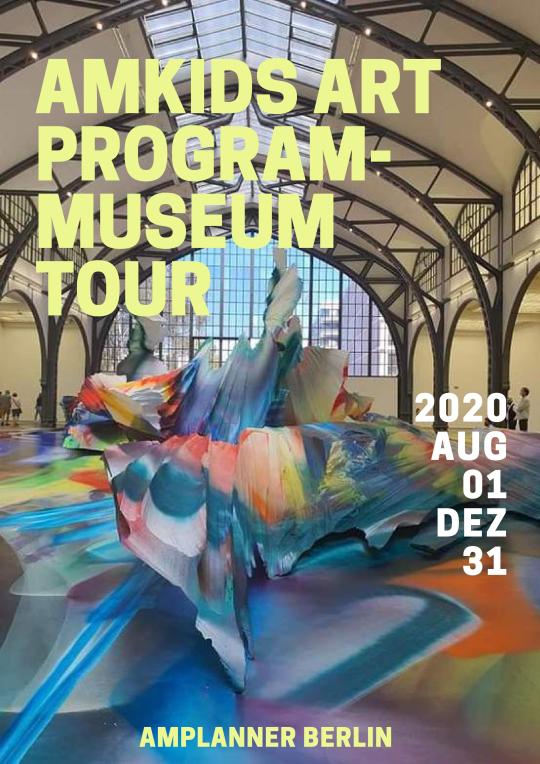
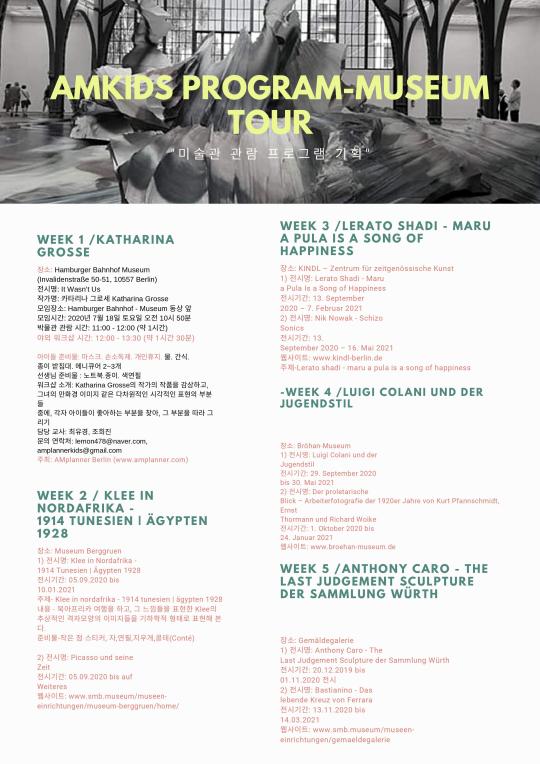
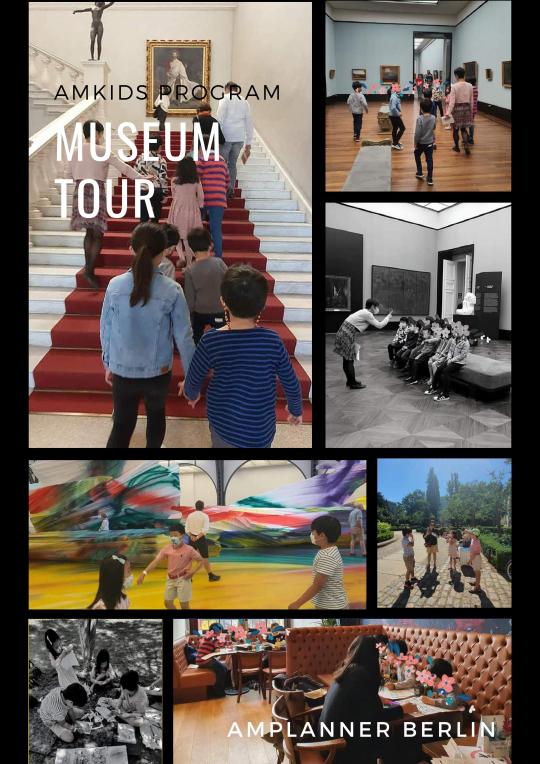
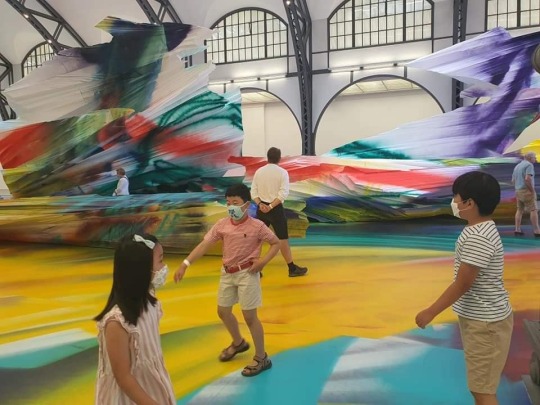
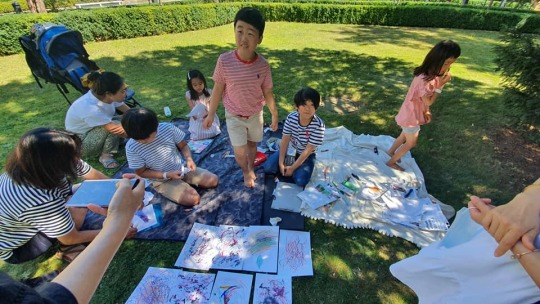

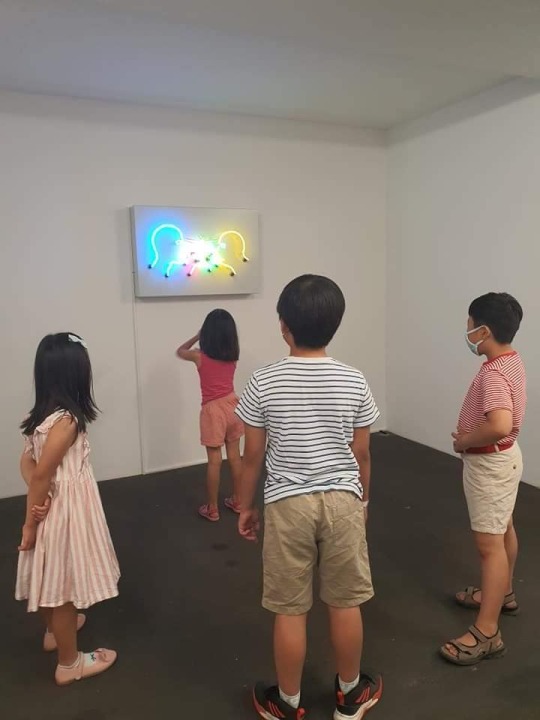

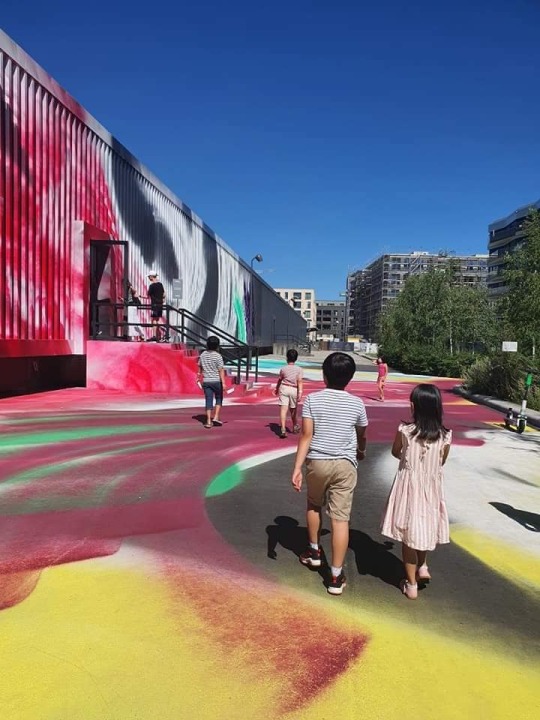
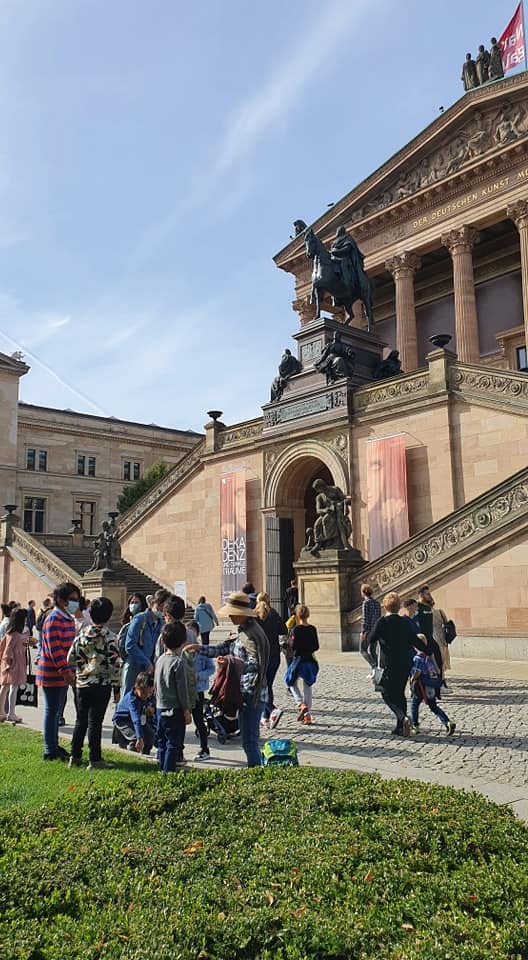
AMkids Program-Museum Tour “미술관 관람 프로그램 기획” Week 1 / 장소: Museum Berggruen 1) 전시명: Klee in Nordafrika - 1914 Tunesien | Ägypten 1928 전시기간: 05.09.2020 bis 10.01.2021 주제- Klee in nordafrika - 1914 tunesien | ägypten 1928 내용 - 북아프리카 여행을 하고, 그 느낌들을 표현한 Klee의 추상적인 격자모양의 이미지들을 기하학적 형태로 표현해 본다. 준비물-작은 점 스티커, 자,연필,지우개,콩테(Conté) 2) 전시명: Picasso und seine Zeit 전시기간: 05.09.2020 bis auf Weiteres 웹사이트: www.smb.museum/museen-einrichtungen/museum-berggruen/home/ Week 2 / 장소: KINDL – Zentrum für zeitgenössische Kunst 1) 전시명: Lerato Shadi - Maru a Pula Is a Song of Happiness 전시기간: 13. September 2020 – 7. Februar 2021 2) 전시명: Nik Nowak - Schizo Sonics 전시기간: 13. September 2020 – 16. Mai 2021 웹사이트: www.kindl-berlin.de 주제-Lerato shadi - maru a pula is a song of happiness 내용-Lerato 그녀의 작품은 자신의 몸을 작업의 중심에 두고 있다. 아이들은 자신의 신체 부분을 도화지에 그리면서 그녀의 표현 방식을 배워본다. 준비물- 연필, 지우개, 빨간색, 파란색 매직, 색연필, 가위, 풀, (풍경사진 -선생님 준비물) Week 3 / 장소: Bröhan-Museum 1) 전시명: Luigi Colani und der Jugendstil 전시기간: 29. September 2020 bis 30. Mai 2021 2) 전시명: Der proletarische Blick – Arbeiterfotografie der 1920er Jahre von Kurt Pfannschmidt, Ernst Thormann und Richard Woike 전시기간: 1. Oktober 2020 bis 24. Januar 2021 웹사이트: www.broehan-museum.de 주제 - Luigi colani und der jugendstil 내용- Luigi 그의 디자인에서 가장 중요한 영감의 원천은 자연의 모습이다. 아르누보의 영향을 받은 장식적인 곡선과 미래 지향적인 독특한 모양은 그의 대표적인 표현 방식이다. 아이들은 자신만의 의자를 드로잉하며, 아르누보의 이미지를 배워본다. 준비물- 연필,지우개,검정매직,색연필, (의자•꽃 잡지, 켈라그라피 프린트-선생님 준비물) Week 4 / 장소: Gemäldegalerie 1) 전시명: Anthony Caro - The Last Judgement Sculpture der Sammlung Würth 전시기간: 20.12.2019 bis 01.11.2020 전시 주제 - Anthony caro - the last judgement sculpture der sammlung würth 내용- Caro ���는 현대 문학과 시각 예술의 전통에서 텍스트와 고대 신화를 주제로 작품을 표현했다. 아이들은 상상속 고대 신화 속 동물을 Polymer Clay로 만들어 본다. 준비물- 폴리머 클레이(Polymer Clay), 클레이용 조각칼, (바닥 비닐, 이쑤시개, 신화 동물 프린트, 플라스틱 조각대-선생님 준비물) 2) 전시명: Bastianino - Das lebende Kreuz von Ferrara 전시기간: 13.11.2020 bis 14.03.2021 웹사이트: www.smb.museum/museen-einrichtungen/gemaeldegalerie Week 5 / 장소: KW Institute for Contemporary Art 1) 전시명: 11th Berlin Biennale for Contemporary Art 전시기간: 5 September – 1 November 20 웹사이트: www.kw-berlin.de 주제-11th berlin biennale for contemporary art 내용- 제 11 회 베를린 비엔날레의 느린 개막은 1 년 전에 ���작되었으며, 그 이후로 우리가 가지고있는 많은 균열, 우리를 갈라 놓는 균열, 우리를 하나로 모으는 균열을 탐구하고 있으며, 비엔날레에 초대 된 많은 예술가와 참가자들은 각자 자신의 예술적 용어로 자신의 맥락과 시간에 따라 이것을 탐구하고 작품으로 표현했다. 아이들은 작가들의 작품을 보고, 각자 인상 깊었던 이미지를 생각하며, 자유롭게 그린다 준비물- 연필,지우개,싸인펜,색연필 Week 6 / 장소: PalaisPopulaire 1) 전시명: Time Present(Deutsche BankCollection) 전시기간: 10.06.2020 bis 08.02.2021 웹사이트: www.db-palaispopulaire.de 주제- Time present (Deutsche Bank Collection) 내용- 시간적,지리적 경계를 넘어 현대 미술의 중심 매체로써 사진은 이미 자리를 잡았다. 시간을 주제로, 아이들은 자신의 성장 과정의 사진들을 가지고, 회색톤으로 표현해 본다. 준비물- 각자 어릴적 사진 몇장, 연필, 지우개, 회색톤의 색연필,가위,풀, (목탄,휴지, 물티슈-선생님 준비물)
0 notes
Photo
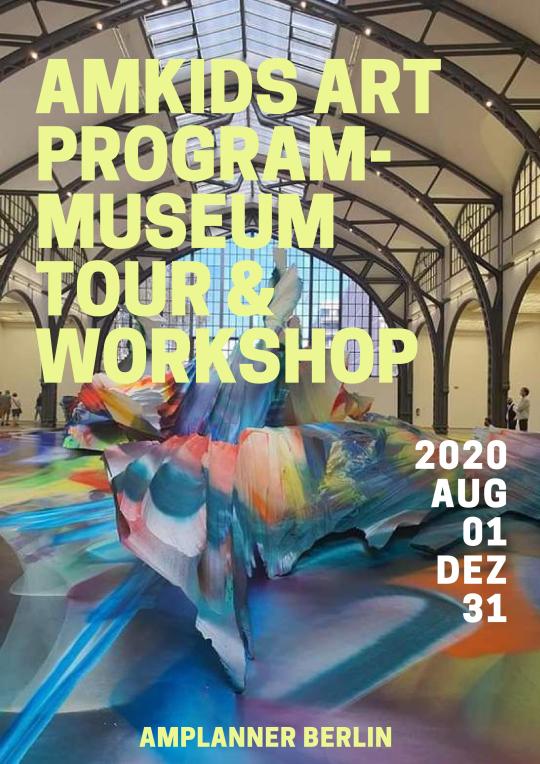
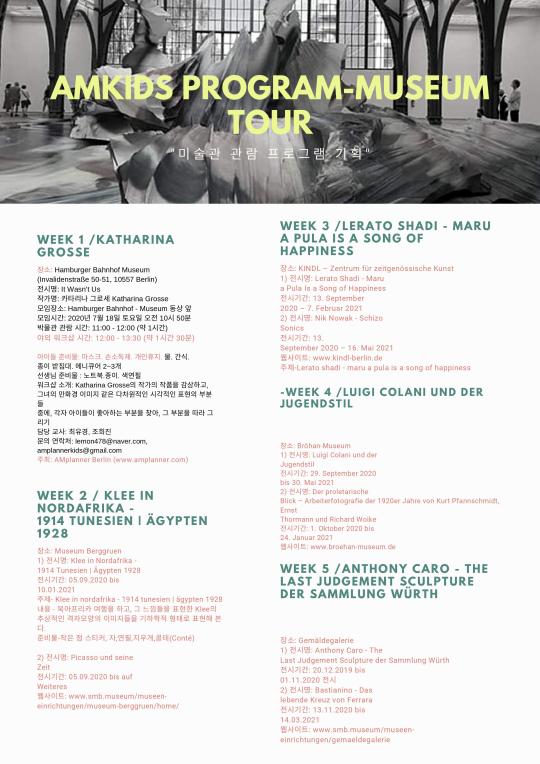

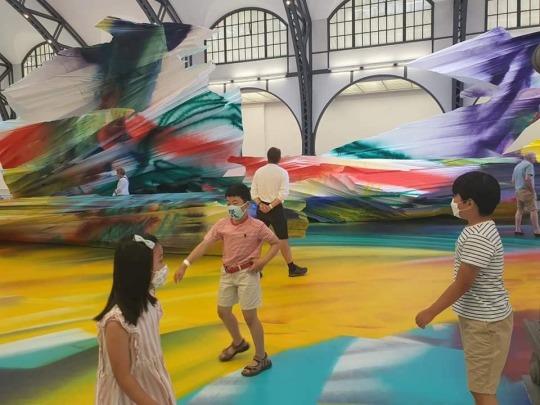

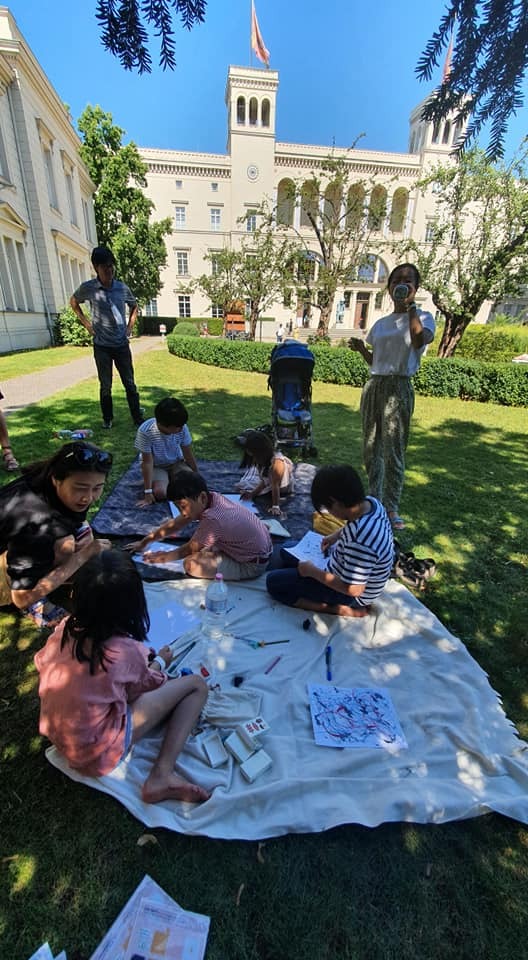

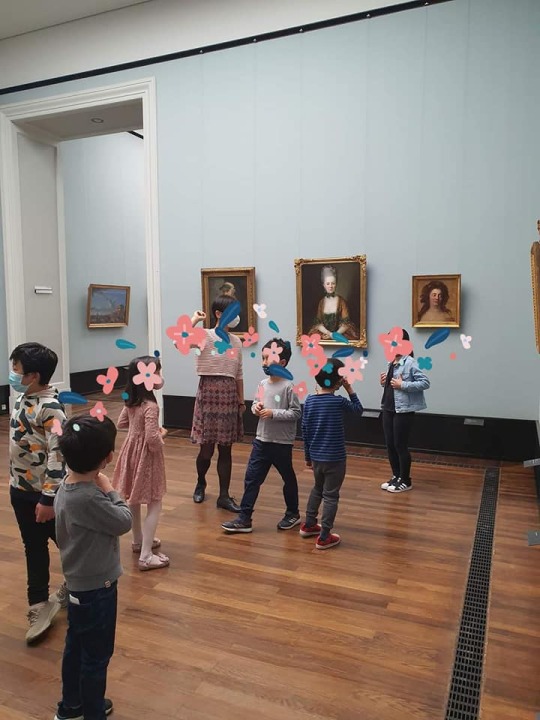
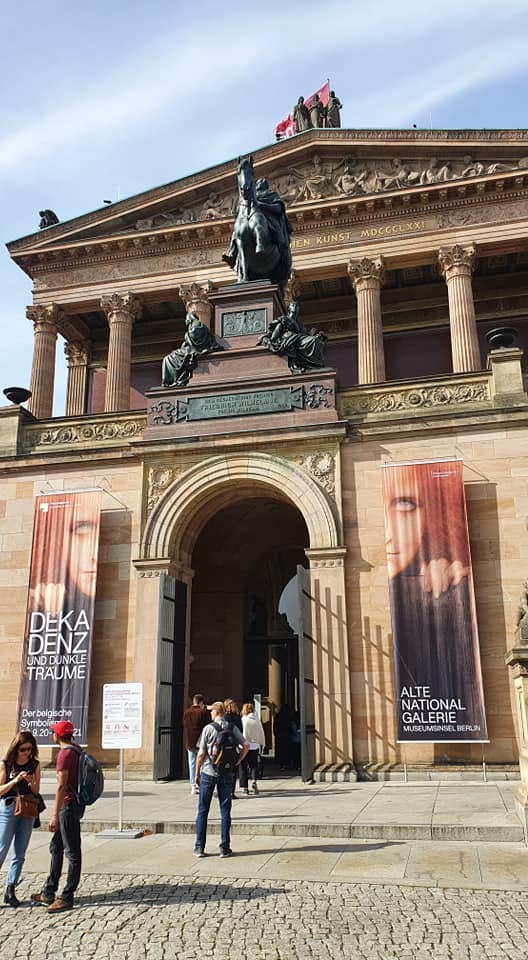

AMkids Program-Museum Tour "미술관 관람 프로그램 기획" Week 1 / 장소: Museum Berggruen 1) 전시명: Klee in Nordafrika - 1914 Tunesien | Ägypten 1928 전시기간: 05.09.2020 bis 10.01.2021 주제- Klee in nordafrika - 1914 tunesien | ägypten 1928 내용 - 북아프리카 여행을 하고, 그 느낌들을 표현한 Klee의 추상적인 격자모양의 이미지들을 기하학적 형태로 표현해 본다. 준비물-작은 점 스티커, 자,연필,지우개,콩테(Conté) 2) 전시명: Picasso und seine Zeit 전시기간: 05.09.2020 bis auf Weiteres 웹사이트: www.smb.museum/museen-einrichtungen/museum-berggruen/home/ Week 2 / 장소: KINDL – Zentrum für zeitgenössische Kunst 1) 전시명: Lerato Shadi - Maru a Pula Is a Song of Happiness 전시기간: 13. September 2020 – 7. Februar 2021 2) 전시명: Nik Nowak - Schizo Sonics 전시기간: 13. September 2020 – 16. Mai 2021 웹사이트: www.kindl-berlin.de 주제-Lerato shadi - maru a pula is a song of happiness 내용-Lerato 그녀의 작품은 자신의 몸을 작업의 중심에 두고 있다. 아이들은 자신의 신체 부분을 도화지에 그리면서 그녀의 표현 방식을 배워본다. 준비물- 연필, 지우개, 빨간색, 파란색 매직, 색연필, 가위, 풀, (풍경사진 -선생님 준비물) Week 3 / 장소: Bröhan-Museum 1) 전시명: Luigi Colani und der Jugendstil 전시기간: 29. September 2020 bis 30. Mai 2021 2) 전시명: Der proletarische Blick – Arbeiterfotografie der 1920er Jahre von Kurt Pfannschmidt, Ernst Thormann und Richard Woike 전시기간: 1. Oktober 2020 bis 24. Januar 2021 웹사이트: www.broehan-museum.de 주제 - Luigi colani und der jugendstil 내용- Luigi 그의 디자인에서 가장 중요한 영감의 원천은 자연의 모습이다. 아르누보의 영향을 받은 장식적인 곡선과 미래 지향적인 독특한 모양은 그의 대표적인 표현 방식이다. 아이들은 자신만의 의자를 드로잉하며, 아르누보의 이미지를 배워본다. 준비물- 연필,지우개,검정매직,색연필, (의자•꽃 잡지, 켈라그라피 프린트-선생님 준비물) Week 4 / 장소: Gemäldegalerie 1) 전시명: Anthony Caro - The Last Judgement Sculpture der Sammlung Würth 전시기간: 20.12.2019 bis 01.11.2020 전시 주제 - Anthony caro - the last judgement sculpture der sammlung würth 내용- Caro 그는 현대 문학과 시각 예술의 전통에서 텍스트와 고대 신화를 주제로 작품을 표현했다. 아이들은 상상속 고대 신화 속 동물을 Polymer Clay로 만들어 본다. 준비물- 폴리머 클레이(Polymer Clay), 클레이용 조각칼, (바닥 비닐, 이쑤시개, 신화 동물 프린트, 플라스틱 조각대-선생님 준비물) 2) 전시명: Bastianino - Das lebende Kreuz von Ferrara 전시기간: 13.11.2020 bis 14.03.2021 웹사이트: www.smb.museum/museen-einrichtungen/gemaeldegalerie Week 5 / 장소: KW Institute for Contemporary Art 1) 전시명: 11th Berlin Biennale for Contemporary Art 전시기간: 5 September – 1 November 20 웹사이트: www.kw-berlin.de 주제-11th berlin biennale for contemporary art 내용- 제 11 회 베를린 비엔날레의 느린 개막은 1 년 전에 시작되었으며, 그 이후로 우리가 가지고있는 많은 균열, 우리를 갈라 놓는 균열, 우리를 하나로 모으는 균열을 탐구하고 있으며, 비엔날레에 초대 된 많은 예술가와 참가자들은 각자 자신의 예술적 용어로 자신의 맥락과 시간에 따라 이것을 탐구하고 작품으로 표현했다. 아이들은 작가들의 작품을 보고, 각자 인상 깊었던 이미지를 생각하며, 자유롭게 그린다 준비물- 연필,지우개,싸인펜,색연필 Week 6 / 장소: PalaisPopulaire 1) 전시명: Time Present(Deutsche BankCollection) 전시기간: 10.06.2020 bis 08.02.2021 웹사이트: www.db-palaispopulaire.de 주제- Time present (Deutsche Bank Collection) 내용- 시간적,지리적 경계를 넘어 현대 미술의 중심 매체로써 사진은 이미 자리를 잡았다. 시간을 주제로, 아이들은 자신의 성장 과정의 사진들을 가지고, 회색톤으로 표현해 본다. 준비물- 각자 어릴적 사진 몇장, 연필, 지우개, 회색톤의 색연필,가위,풀, (목탄,휴지, 물티슈-선생님 준비물)
0 notes
Photo

Chained, 2020 (detail), 400 cm in diameter, resin, fiberglass, paper, glue, courtesy the artist, commissioned by the 11th Berlin Biennale, photo by Elmar Vestner
Exhibited at the 11th Berlin Biennale, The Crack Begins Within, KW Institute for Contemporary Art, 05.09–01.11.2020
0 notes
Photo

11th Berlin Biennale: On The Human Condition
An interview by Katerina Valdivia Bruch
The latest issue of the journal On Curating has been published and it includes my interview with the curators of the 11th Berlin Biennale.
“The 11th Berlin Biennale chose to start its activities one year before its opening date. Following a process-based curatorial approach, the team of four curators began its undertaking at the ExRotaprint complex, working in small groups, and involving the locals and the artistic community. The programme includes reflections and discussions around vulnerability, care and solidarity, as well as extractivism, fanaticism and the rise of nationalisms. While a worldwide pandemic has forced us to stop and go back to basics, all these issues have become more urgent than ever. We spoke with the curators on creating sustainable relationships, doing things on a human scale, and the meaning of community in times of the pandemic.” >>
#BerlinBiennale#OnCurating#LisetteLagnado#RenataCervetto#MaríaBerrios#AgustínPérezRubio#KaterinaValdiviaBruch#contemporary art
0 notes
Photo

In order to stay connected during these exceptional times, we have started a blog in which we will share some information on topics related to the project Rethinking Conceptualism and its participants. Interviews, articles, essays and videos will follow.
In this interview with the curators of the Berlin Biennale, Lisette Lagnado speaks about the importance of working together and tells us about her experience with the co-curators of the biennale (the interview is in Spanish and German).
Let's stay in touch!
*
Para seguir conectados durante este tiempo de excepción, hemos creado este blog donde empezaremos a compartir material con información sobre algunos temas relacionados con el proyecto Repensar el conceptualismo y los participantes del mismo. Incluiremos entrevistas, artículos, ensayos y videos.
Aquí los dejamos con una entrevista a las curadoras de la Bienal de Berlín. En ella, Lisette Lagnado habla sobre la importancia del trabajo en conjunto y nos cuenta sobre su experiencia con las co-curadoras de la bienal.
¡Sigamos en contacto!
Interview/Entrevista: Katerina Valdivia Bruch for/para el Goethe-Institut Argentinien
Photo: Curators of the 11th Berlin Biennale/Curadores de la undécima Bienal de Berlín. From left to right/De izquierda a derecha: Renata Cervetto, Agustín Pérez Rubio, María Berríos, Lisette Lagnado © F. Anthea Schaap
0 notes
Text

11th Berlin Biennale for Contemporary Art announces dates and venues for epilogue. BMW again Corporate Partner of the 11th Berlin Biennale for Contemporary Art. http://dlvr.it/RPMWmm http://dlvr.it/RPMWmm
0 notes
Text

11th Berlin Biennale for Contemporary Art announces dates and venues for epilogue. BMW again Corporate Partner of the 11th Berlin Biennale for Contemporary Art. http://dlvr.it/RPMWmj http://dlvr.it/RPMWmj
0 notes
Text

11th Berlin Biennale for Contemporary Art presents first program from September 7 to November 9, 2019, with press view the day before. BMW again Corporate Partner of the 11th Berlin Biennale for Contemporary Art. http://dlvr.it/RC5FW7 http://dlvr.it/RC5FW7
0 notes